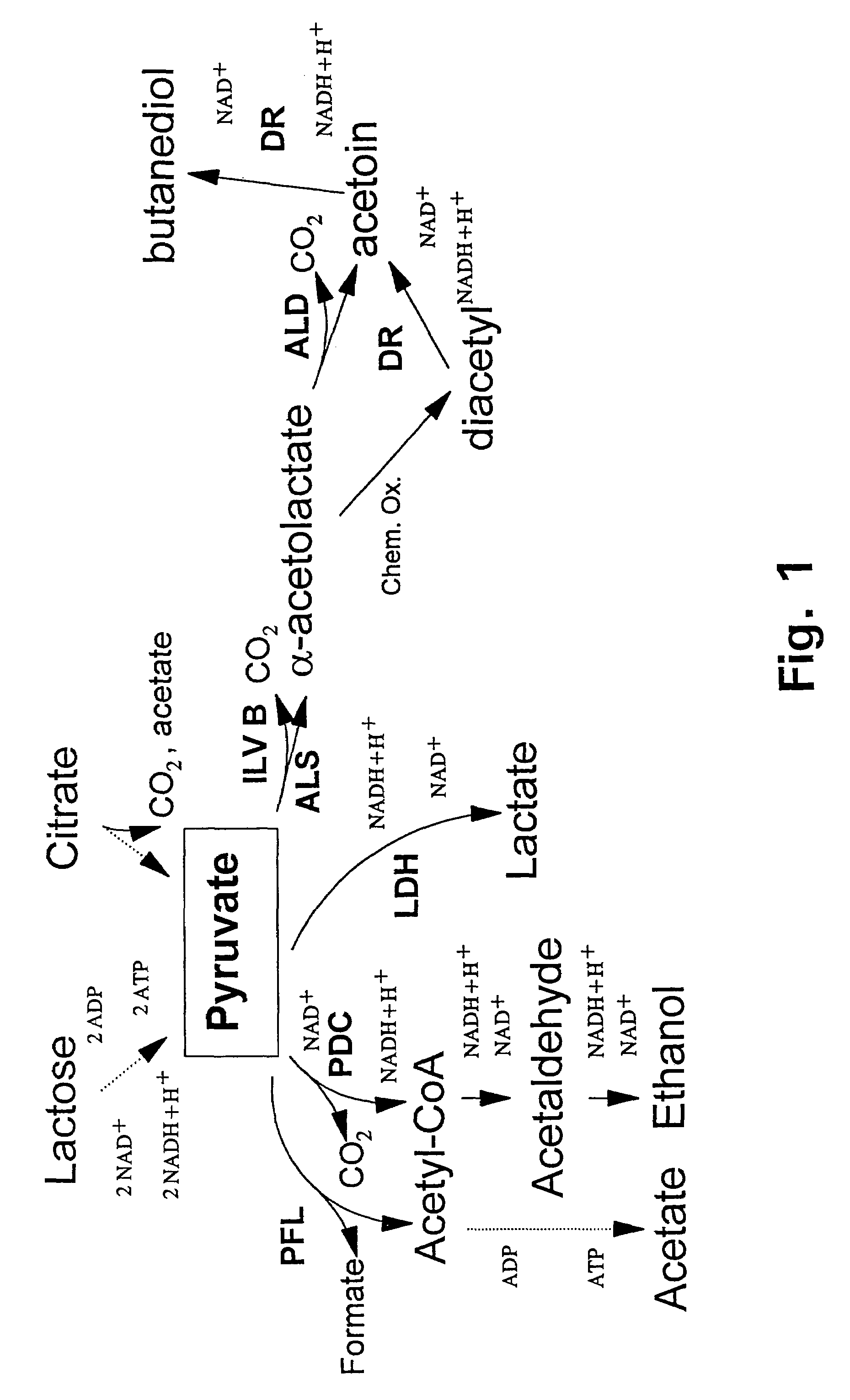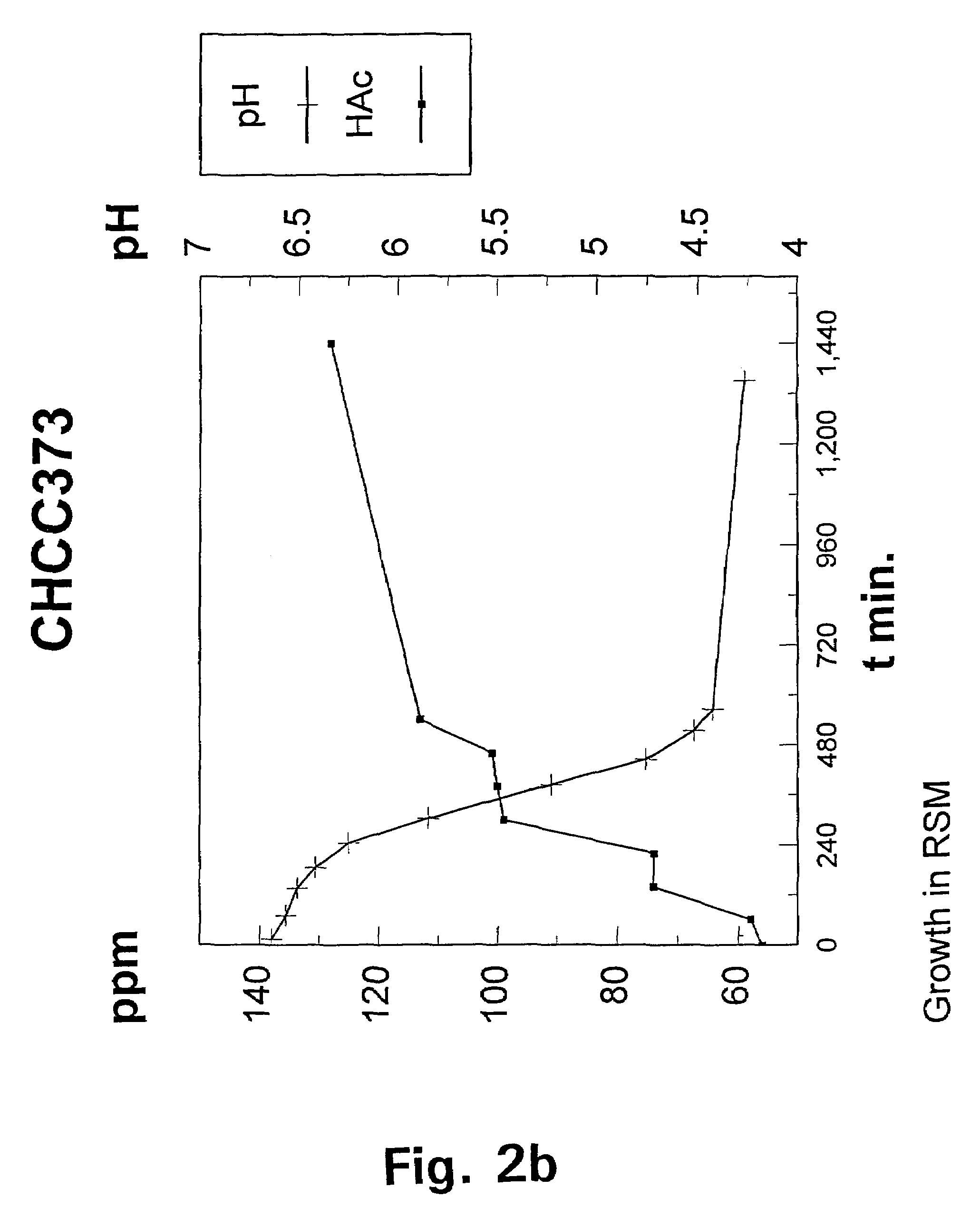Metabolically engineered lactic acid bacteria and their use
a lactic acid bacteria and bacterial technology, applied in the field of lactic acid bacterial starter cultures, can solve the problems of low ph, inability or possible to suggest inactivation of pfl activity by aeration and/or low ph, and generally not desirable to lower the ph of food materials. , to achieve the effect of reducing the growth rate and reducing the acid production ra
- Summary
- Abstract
- Description
- Claims
- Application Information
AI Technical Summary
Benefits of technology
Problems solved by technology
Method used
Image
Examples
example 1
Acetate Requirement for Growth of L. lactis
[0088]Initially, the L. lactis subspecies lactis strains 1FHCY-1 and MG1363 were tested for growth on DN-medium with (DN) or without (DN-Ac) acetate, respectively.
[0089]The above mentioned strains were streaked onto DN and DN-Ac agar plates, respectively. The plates were incubated for 24 hours under anaerobic and aerobic conditions, respectively. The results are summarized in Table 1 below:
[0090]
TABLE 1Acetate requirement of 1FHCY-1 and MG1363AerobicAnaerobic+Ac−Ac+Ac−AC1FHCY-1+++−++++++MG1363+++−+++++++++: colony size 0.5-1 mm;−: no growth after prolonged incubation
The tested L. lactis strains have an absolute requirement for acetate under aerobic growth conditions.
[0091]The wild-type strain Lactococcus lactis subspecies lactis CHCC373 was selected from the culture collection of Chr. Hansen A / S, Hørsholm, Denmark and tested for its growth requirement for acetate under aerobic and anaerobic conditions respectively by streaking a liquid cul...
example 2
Isolation of Pfl Defective Mutants of Lactococcus Lactis Subspecies Lactis CHCC373 and Lactococcus Lactis Subspecies Lactis Biovar Diacetylactis DB1341 and Characterization hereof
2.1. Isolation of Mutants
[0094]Mutagenized stocks of the strains CHCC373 and DB1341 were prepared as described above and plated in dilutions onto DN-medium agar plates which were incubated aerobically for 24 to 48 hours. From these plates, 980 colonies of each strain were selected and streaked onto DN and DN-Ac agar plates, respectively and these plates were incubated for 24 hours under anaerobic conditions. Two strains designated DN220 and DN221, respectively from the mutagenized CHCC373 strain and one strain designated DN227 from the mutagenized DB1341 strain which were unable to grow in the absence of acetate under anaerobic conditions were selected.
[0095]Chromosomal DNA was isolated from DN220, DN221 and CHCC373, respectively and digested with EcoRI, and the fragment patterns were compared using agarose...
example 3
Isolation of Pfl and Ldh Defective Mutants and Characterization hereof
3.1. Isolation of Mutants
[0100]A stock of DN221 was mutagenized as described above under Materials and Methods, and the mutagenized cells were plated in dilutions onto DN-medium agar plates which were incubated aerobically for 24-48 hours. From theses plates, 980 colonies were selected and each colony was streaked onto two DN plates and incubated 24 hours under anaerobic and aerobic conditions, respectively. Two strains (DN222 and DN223) which were unable to grow under anaerobic conditions were selected.
[0101]Chromosomal DNA was isolated from DN222, DN223 and CHCC373, respectively and digested with EcoRI. The fragment patterns were compared using agarose gel electrophoresis. The fragment patterns showed that both DN222 and DN223 originate from CHCC373.
[0102]Sample of DN222 and DN223, respectively were deposited with Deutsche Sammlung von Mikroorganismen und Zellkulturen GmbH, Mascheroder Weg 1b, D-38124 Braunschwe...
PUM
 Login to View More
Login to View More Abstract
Description
Claims
Application Information
 Login to View More
Login to View More - R&D
- Intellectual Property
- Life Sciences
- Materials
- Tech Scout
- Unparalleled Data Quality
- Higher Quality Content
- 60% Fewer Hallucinations
Browse by: Latest US Patents, China's latest patents, Technical Efficacy Thesaurus, Application Domain, Technology Topic, Popular Technical Reports.
© 2025 PatSnap. All rights reserved.Legal|Privacy policy|Modern Slavery Act Transparency Statement|Sitemap|About US| Contact US: help@patsnap.com



